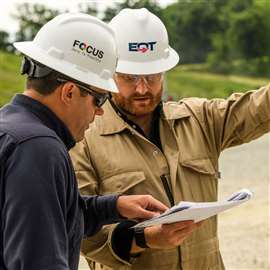EQT touts emissions milestone
October 31, 2024
Company hits GHG goal earlier than scheduled
EQt Corp., America’s leading producer of natural gas, said has reached net zero Scope 1 and Scope 2 greenhouse gas emissions across the company’s legacy operations ahead of its 2025 goal.
This goal covers the entirety of EQT’s upstream operations, including the recently acquired Tug Hill/XcL Midstream and Alta Resources assets, which were not part of the original target set in 2021 and combined represented an approximately 52% increase relative to starting-point emissions, the company said.
 EQT Corp., America’s leading producer of natural gas, said has reached net zero Scope 1 and Scope 2 greenhouse gas emissions across the company’s legacy operations ahead of its 2025 goal. (Image: EQT)
EQT Corp., America’s leading producer of natural gas, said has reached net zero Scope 1 and Scope 2 greenhouse gas emissions across the company’s legacy operations ahead of its 2025 goal. (Image: EQT)
“In 2019, EQT announced its vision to become the operator of choice for all stakeholders,” said Toby Z. Rice, President and CEO of EQT. “As part of our efforts, we assessed our business and established a climate change strategy that set a bold emissions reduction goal. At the time of announcement, this required a reduction or offset of over 600,000 MT CO2e.2 We are proud to reach this historic milestone as the first traditional energy producer of scale to achieve net zero.”
EQT said it achieved this net zero status primarily through emissions abatement, with the remainder offset with company-generated offsets rather than purchased credits. Looking ahead, EQT remains committed to continuing its leadership through its new NetZero Now+ initiative.
EQT’s approach focused on significant in-house emissions reductions that targeted the leading sources of EQT’s emissions, supplemented by carbon offset generation, including:
Pneumatic Device Replacement: Between June 2021 and December 2022, EQT replaced or retrofitted over 9,000 pneumatic devices, resulting in an annual reduction of approximately 300,000 MT CO2e.
Electrification of Frac Fleets: Starting in 2020, EQT replaced conventional diesel fleets with electric fleets powered by natural gas-fired turbines using EQT-produced natural gas. This initiative reduced EQT’s carbon footprint by an estimated 35,000-50,000 MT CO2e annually.
Combo Development: By the end of 2019, EQT implemented its “combo-development” approach, which applies advanced digital technologies and long-range well planning to its operational strategy. This approach improves drilling operations by approximately 30% and significantly reduces greenhouse gas emissions.
Emissions Control Devices on Acquired Alta Assets: Following the acquisition of Alta Resources, EQT installed emissions control devices on these assets, eliminating approximately 35,000 MT CO2e of GHG emissions from the assets.
Advanced Methane Monitoring and Mitigation: In 2023, EQT helped establish the Appalachian Methane Initiative, a world-class sector and technology-agnostic methane monitoring network designed to provide greater efficiency in the identification and remediation of potential fugitive methane emissions from operations in the Appalachian Basin through coordinated satellite and aerial surveys on a geographic-basis.
Local Carbon Offset Projects: EQT developed an initiative to offset its remaining 2023 Scope 1 and Scope 2 GHG emissions with nature-based carbon sequestration projects in partnership with the state of West Virginia. The initiative includes conservation management practices such as the removal of invasive species, wildfire risk monitoring, and native tree and shrub placement. These efforts are verified by West Virginia University, ensuring both economic and environmental benefits to the region.
EQT’s NetZero Now+ initiative reflects EQT’s current achievement of attaining net zero with respect to its 2023 Scope 1 and Scope 2 GHG emissions, as well as its aspiration to achieve net zero Scope 1 and Scope 2 GHG emissions across all EQT assets in future years.
“This achievement undoubtedly reflects the hard work of our incredible team to revolutionize our operations to effectively reduce our emissions while at the same time achieving peak performance and driving value,” Rice said. “However, EQT’s becoming the first traditional energy producer of scale in the world to achieve this net zero status is thanks to the low-emissions foundation established within our operating footprint in the Appalachian Basin — one of the largest, low-cost deposits of traditional energy in the world.”
MAGAZINE
NEWSLETTER

CONNECT WITH THE TEAM







